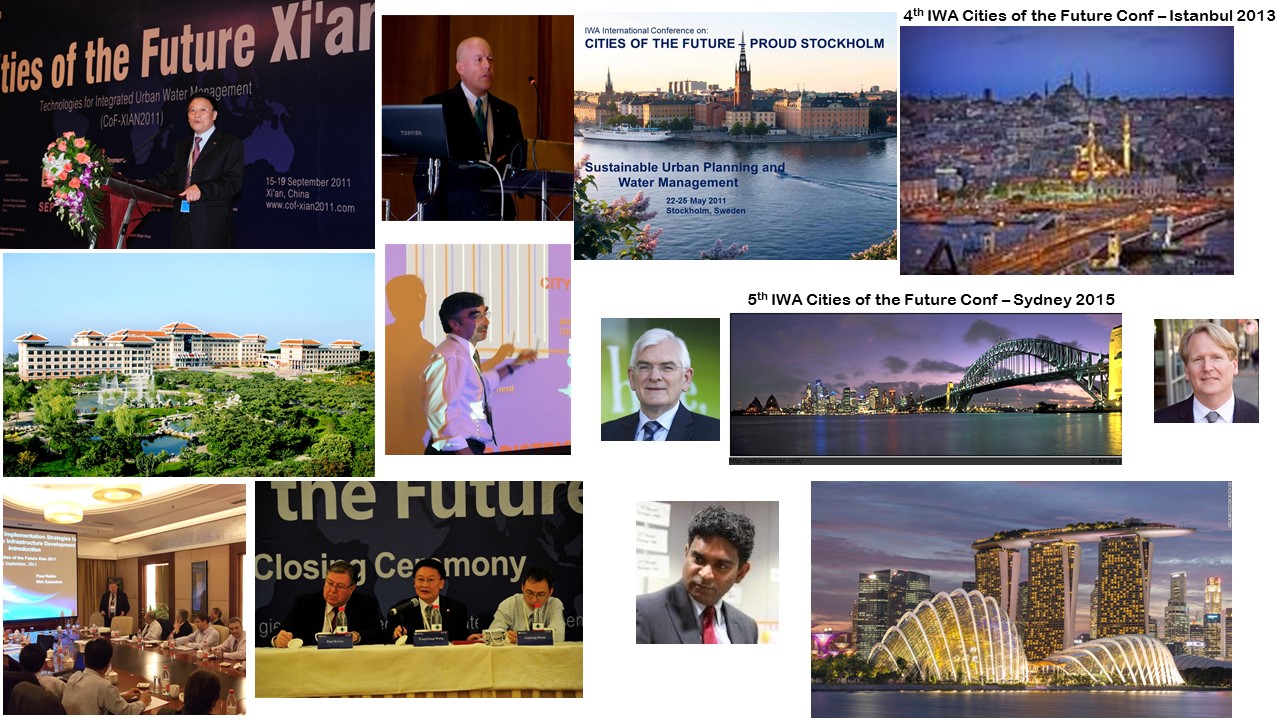
Role: Jointly created and led IWA’s path-breaking program
Leader of the IWA Cities of the Future program for realizing new and hybrid approaches to water system design, city planning and development
Approximately one million new arrivals in the world’s cities each week – “we need a new paradigm for environmental infrastrucuture development”
Details
The Underpinnings of Today’s Challenges
Water is essential to life – no water, no life. Unlike air, the distribution of water is mal-distributed and seasonal. Accordingly, throughout the millennia, most sizable human settlements have been developed in close proximity to fresh water. With a meagre population of less that 1 billion people on the planet, this model worked, on average, through the advent of the renaissance in Europe. Growth started to accelerate in the renaissance and by the 1700’s, a fully evident exponential growth pattern manifested itself – a pattern that that continues today. To scholars like Thomas Mathus, it became evident that providing food and water to the burgeoning population was going to be truly challenging, if not impossible.
In the western world, the Industrial Revolution accelerated the trends in growth in population, and perhaps most importantly, in urbanization and urban density over the period between the 1800’s and 2000. This process placed extreme pressure on the water environment – both in terms of supplying water to cities and the ability to absorb pollution. Remember that in the context of the industrial revolution and manufactured goods, water use grows far faster than population because water is used for more and more things in advanced economies.


Brilliant engineering breakthroughs that provided safe water to the masses and isolated life threatening sources of pollution”
The Recent Past (~200 years)
At 2 billion people on the planet in the late 1800’s, brilliant Victorian engineering breakthroughs in drinking water and sewerage management, in the context of the industrialization and rapid urbanization of Britain and Europe — so effective that they revolutionized the water side of urbanity and made dense cities safely inhabitable.
However, in the process, the circumstances of the times and the relative abundance of water in England and Northern Europe inadvertently locked global thinking into an unfortunate paradigm of “procure/use once/pollute/dispose it”. In this mindset, a community ideally procures water as far upstream as possible, uses it once, collects the wastewater and disposes it into the river or ocean far outside of the city. Several major consequence of this paradigm were:
- A system that required a huge amount of freshwater to complete the cycle
- The creation of a monotonic increase in local and ultimately global water pollution, mitigated even today in only the wealthiest 10% of the world’s population
- A reliance on major piped systems that: were expensive to build and maintain; required a lot of energy; and that are still economically out of reach for much of the worlds population
- The piping & treatment systems built to accomplish this had no thought of reusing water or notions of nodes in the system that could facilitate reuse nearby.
Approximately one million new arrivals in the world’s cities each week – “we need a new paradigm for environmental infrastructure development”
Today… And More Importantly, Tomorrow
At a population of 4 billion in the mid-1900’s, this reality was definitely aided by revolutions in used water treatment in a small fraction of countries that could afford it. By 2000, the population was about 7 billion. About 1 billion had wastewater treatment, the rest did not. Water shortages were looming and a population 9-10 billion people was to come by 2100.
Many water professionals say that this model for urban water use – which has become the prevalent model in the world today – needs to be significantly revised to:
- Use water much more efficiently to begin with
- Enable high levels of water reuse
- Greatly reduce energy use associated with water distribution, collection and treatment
- Strategically reduce centralization of the system to reduce costs and increase resilience
Other water professionals – notably those from water-rich countries with no significant population growth in the past 50 years and plenty of money — say the traditional model has worked fine and that the addition of advanced centralized wastewater treatment has mitigated the pollution problems.
Creation of the IWA Cities of the Future Program provided an important tool for many water professionals to think through the needed evolution in our historical approach and embrace a more realistic and resilient framework for urban water development in the future.


The Program














